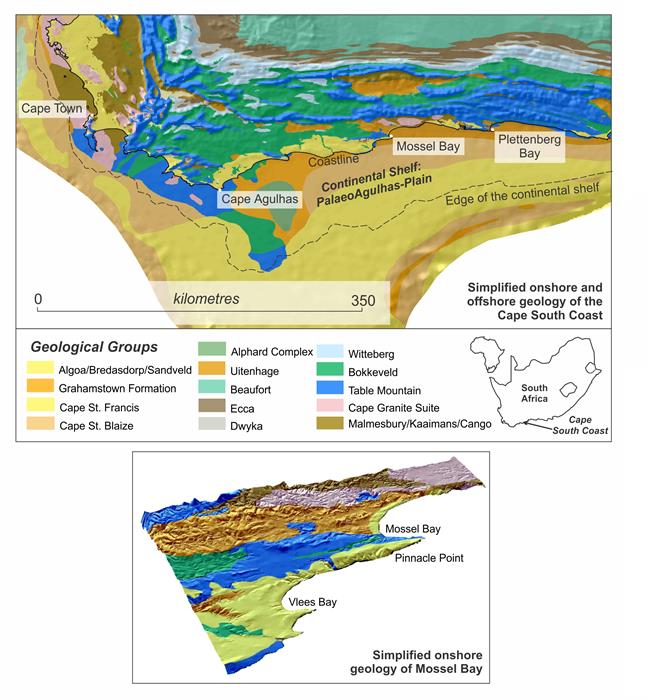MOSSEL BAY NEWS - If you are new in town, you might be interested in the types of stones one sees in the Mossel Bay area.
The sandstone buildings are an attractive feature and several of the walls in town are notable because they are built from stones of varying colours, such as beige, pink, mauve, orange, yellow, red, grey and brown.
Walking on the beach, smooth, white rounded pebbles, much like marble which a sculptor would use, can be seen.
Flecks which sparkle
There are also stones with glittery flecks which sparkle in the sunlight.
The Mossel Bay Advertiser asked geologist Hayley Cawthra to name the types of stones found in the Mossel Bay area.
With regard to the stones numbered 1 to 6, in the picture below, Cawthra said:
- "This looks like quartz. The black might be manganese staining. The yellowish tint is usually from inclusions of iron in the actual crystal lattice structure.
- "I think this is also quartz, but more "pure" and white, and lacking inclusions of things such as iron.
- "A chunk of granite or gneiss. The shiny bits are biotite mica. The white parts are quartz and feldspar. These minerals are 'fused' into a rock, but are visible because granite is an igneous rock that forms slowly in batholiths in the lower crust or upper mantle of the earth, and the slow formation in a magma chamber allows for larger crystals than something like a volcanic eruption that has small crystals.
- "This is a chunk of sandstone and the white stripe is a vein of quartz in the stone.
- "Probably also a piece of granite and the pinkish minerals are feldspar crystals.
- "It might be an iron-stained sandstone (like 4) but with fragments of quartz."

Cawthra says of the map below:
"The oldest rocks in the area are shown in brown and are the Kaaimans Group shales. These were intruded by the Cape Granite Suite and in this case, are represented by the George Pluton which is pink on the map and crops out along the coast east of Glentana towards George.
"The blue deposits are the Table Mountain Group sandstones and in this area, are specifically the Skurweberg Formation quartzites. "Quartzite is a rock made up of almost 100% quartz crystals and in the Cape, it has been lightly metamorphosed or modified by higher-than-normal temperature and pressure conditions.
"Note that along the cliffed coast near Pinnacle Point, these Skurweberg Formation quartzites are draped by younger sediments (yellow) but they are clearly visible along the Cape St Blaize trail.
"The Bokkeveld Group shales (green on the geological map) have become weathered into fertile soils and as a result, are heavily vegetated and not clearly visible in the outcrops in Mossel Bay.

Indian Ocean opened
"The Cape Fold Belt was deformed into the mountains we know today. Following this compression, the supercontinent Gondwana broke up and the Indian Ocean opened. Then the orange Uitenhage Group rocks were laid down.
"Be sure to look out for fossils in the rocks from the Robberg Formation, which are used in the buildings of Mossel Bay. During the break-up of the supercontinent Gondwana, this pulling apart resulted in structural deformation in older rocks.
"Small fractures that formed in the Skurweberg Formation quartzites were infilled by quartz mineral fluids. These "stripes" are often white and are commonly observed in the rocks of Mossel Bay.
"The youngest geological deposits in the area are beach and dune rocks, laid down on ancient coasts above and below the present coastline. These are best seen at low tide between Hartenbos and the the Great Brak River mouth, as well as on the Dana Bay beaches. "The above-sea-level outcrops at Little Brak and Dana Bay are some of the best examples worldwide of the coastal rock remnant of an 11m higher-than-present sea level."
Shiny
Speaking further about quartzite, Cawthra says:
- "The quartzite rocks of the Skurweberg Formation are greyish white and are made up mostly of the mineral quartz (hence the name). These are lightly metamorphosed sandstones and mineral boundaries become fused. This is why they can also appear shiny when they are wet.
- "A pink or orange tint or staining in rocks is a result of inclusions of iron in the mineral matrix.
- "Black streaks are usually from manganese.
- "White 'stripes' in a rock are vein quartz, that intruded after a rock was already formed."
Cawthra has a PhD in geological science from the University of Cape Town. Her PhD thesis was titled, "The marine geology of Mossel Bay". She points out that geologically, the seabed is much the same as the land.
She is the chief geologist: marine geoscience at the Council for Geoscience Western Cape regional office and she is a research associate in the African Centre for Coastal Palaeoscience at Nelson Mandela University.
For more information, go to www.geology.com. This useful website explains the three different classifications of rocks - igneous, metamorphic and sedimentary - as well as the different rocks in these categories in simple, easy terms.
'We bring you the latest Mossel Bay, Garden Route news'















